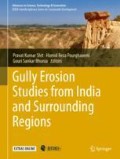Abstract
Soil erosion is a major challenge, especially in hilly areas and countries. This study presents the results of erosion control in Nilgiris area, one of the hilly regions in India located at Western Ghats of Tamilnadu. This area experiences gully erosion that causes slope instability. In this study, an attempt was made to investigate the effect of rainfall in causing gully soil erosion in this landslide-prone area, while considering factors such as varying soil density, slope angle and rainfall intensity. The study also investigated the remediation of gully erosion using vetiver, a soil bioengineering approach. A soil simulator filled with the landslide-prone soil with and without the plant roots was used at different slopes. The rate of soil erosion was studied. Soil samples were collected from the simulator and tested for its engineering properties. Results obtained showed that the slope angle has an effect on soil erosion and erosion varies inversely with density. Pore water pressure generation during rainfall creates instability among the topsoil surface, which becomes susceptible to soil erosion. HydroCAD was used in modelling the runoff over the soil surface. Soil erosion was found to occur with an increase in velocity of rainwater, which erodes the top fertile soil and triggers sheet erosion. Generally, the vetiver root was found to be efficient for the minimization of gully erosion in the Nilgiris district.
Access this chapter
Tax calculation will be finalised at checkout
Purchases are for personal use only
References
Al-Durrah, M.M. and Bradford, J.M., 1982. The Mechanism of Raindrop Splash on Soil Surfaces 1. Soil Sc. Soc. of America Jr. 46(5): pp. 1086-1090.
Cruse, R.M. and Larson, W.E. (1977) Effect of soil shear strength on soil detachment due to raindrop impact. Soil Sci. Soc. Am. J., 41, 777–81.
Fattet, M. et al. 2011. “Effects of Vegetation Type on Soil Resistance to Erosion: Relationship between Aggregate Stability and Shear Strength.” Catena. DOI: https://doi.org/10.1016/j.catena.2011.05.006
Haregeweyn, N., Tsunekawa, A., Poesen, J., Tsubo, M., Meshesha, D. T., Fenta, A. A., … Adgo, E. (2017). Comprehensive assessment of soil erosion risk for better land use planning in river basins: Case study of the Upper Blue Nile River. Science of the Total Environment, 574, 95–108
Howell, J H. “Introducing Bio-Engineering to the Road Network of Himachal Pradesh.”
Hurni, H. (1985) Erosion-productivity-conservation systems in Ethiopia. In: Proceedings of paper presented at the 4th international conference on soil conservation, Maracay, Venezuela
Ionita, I., Fullen, M. A., Zgłobicki, W. and Poesen, J. 2015. Gully erosion as a natural and human-induced hazard. Natural Hazards, 79(S1), 1–5. doi: https://doi.org/10.1007/s11069-015-1935-z
Laflen, J.M., Thomas, A.W. and Welch, R., 1987. Cropland experiments for the WEPP project. American Society of Agricultural Engineers (Microfiche collection)(USA). no. fiche no. 87-2544.
Norris, Joanne E, and John R Greenwood. “Assessing the Role of Vegetation on Soil Slopes in Urban Areas.”In Proceedings of the 10th IAEG International Congress, IAEG2006 (2006), 744 by Joanne E. Norris, John R. Greenwood
Pani, Padmini. 2016. “Development in Practice Controlling Gully Erosion : An Analysis of Land Reclamation Processes in Chambal Valley, India.” 4524 (November). doi:10.1080/09614524.2016.1228831.
Partap, T. and Watson, H.R., 1994. Sloping agricultural land technology (SALT): A regenerative option for sustainable mountain farming. available at http://agris.fao.org/agris-search/search.do?recordID=QZ1998000050 accessed during February 2019
Poesen, J., Nachtergaele, J., Verstraeten, G., & Valentin, C. (2003). Gully erosion and environmental change: Importance and research needs. CATENA, 50, 91–133. doi:https://doi.org/10.1016/S0341-8162(02)00143-1
Poesen, J., Vandaele, K. and van Wesemael, B., 1996. Contribution of gully erosion to sediment production in cultivated lands and rangelands. IAHS Publ., 236, 251–266.
Polster, D.F. 1989. Successional reclamation in Western Canada: New light on an old subject. Paper presented at the Canadian Land Reclamation Association and American Society for Surface
Polster, David F. “Soil Bioengineering for Slope Stabilization and Site Restoration 1.”
Rauws, G. and Covers, G., 1988. Hydraulic and soil mechanical aspects of rill generation on agricultural soils. Jr. Of Soil Sci, 39(1), pp. 111-124.
Tengbeh, G.T., 1989. The effect of grass cover on bank erosion, Ph.D thesis, Silsoe College, Cranfield Institute of Technology
Schiechtl, H.M. and R. Stern. 1997. Water Bioengineering Techniques for Watercourse, Bank and Shoreline Protection. Trans. By L. Jaklitsch. Blackwell Scientific. Oxford, U.K. 185 pp.
Valentin, C., Poesen, J. and Li, Y. 2005. Gully erosion: Impacts, factors and control. Catena, 63(2–3), 132–153. doi: https://doi.org/10.1016/j.catena.2005.06.001
Vanmaercke, M., Poesen, J., Van Mele, B., Demuzere, M. and Bruynseels, A., 2016. How fast do gully headcuts retreat?. Earth-Science Reviews, 154, pp. 336-355.
Waldron, L.J. and Dakessian, S., 1981. Soil reinforcement by roots: calculation of increased soil shear resistance from root properties. Soil science, 132(6), pp. 427-435.
Zhang, Xiyu, Jianrong Fan, Qing Liu, and Donghong Xiong. 2017. “The Contribution of Gully Erosion to Total Sediment Production in a Small Watershed in Southwest China.” Physical Geography 3646 (July): 0. doi:https://doi.org/10.1080/02723646.2017.1356114.
Author information
Authors and Affiliations
Editor information
Editors and Affiliations
Rights and permissions
Copyright information
© 2020 Springer Nature Switzerland AG
About this chapter
Cite this chapter
Gobinath, R. et al. (2020). Soil Erosion Protection on Hilly Regions Using Plant Roots: An Experimental Insight. In: Shit, P., Pourghasemi, H., Bhunia, G. (eds) Gully Erosion Studies from India and Surrounding Regions. Advances in Science, Technology & Innovation. Springer, Cham. https://doi.org/10.1007/978-3-030-23243-6_20
Download citation
DOI: https://doi.org/10.1007/978-3-030-23243-6_20
Published:
Publisher Name: Springer, Cham
Print ISBN: 978-3-030-23242-9
Online ISBN: 978-3-030-23243-6
eBook Packages: Earth and Environmental ScienceEarth and Environmental Science (R0)

